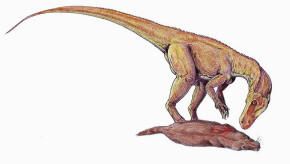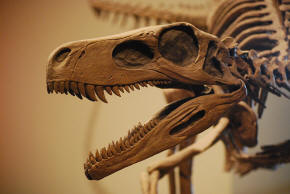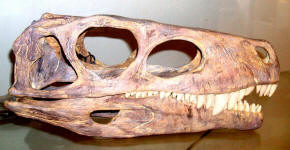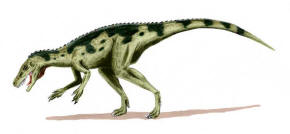|
Description
Editor's Note:
For this first lesson on a specific dinosaur species, many links
have been left in, so the student can familiarize themselves with
terms that may be unfamiliar to them. |
Herrerasaurus was a lightly-built bipedal
carnivore with a long tail and a relatively small head. Its length is
estimated at 3 to 6 meters (10 to 20 ft), and its hip height at more than
1.1 meters (3.3 ft). It may have weighed around 210–350 kilograms
(463–772 lb). In a large specimen at first thought to belong to a separate
genus, Frenguellisaurus, the skull measured 56 centimeters (1.8 ft)
in length. Smaller specimens had skulls which measured around 30 centimeters
(1 ft) in length.
Skull
Herrerasaurus
had a long, narrow skull that lacked nearly all the specializations that characterized later dinosaurs, and more closely
resembled those of more primitive
archosaurs such as
Euparkeria. It had
five pairs of
fenestrae (skull
openings) in its skull, two pairs of which were for the eyes and nostrils.
Between the eyes and the nostrils were two
antorbital fenestrae
and a pair of tiny, 1-centimeter-long (0.4 in) slit-like holes called
promaxillary fenestrae. Behind the eyes were
large
infratemporal fenestrae.
These holes helped to reduce the weight of the skull.
Herrerasaurus
had a flexible joint in the lower jaw, allowing it to slide back and forth
to deliver a grasping bite. This cranial
specialization is unusual among the dinosaurs but has evolved independently
in some lizards. The rear of the lower jaw also
had fenestrae. The jaws were equipped with large serrated teeth for biting
and eating flesh, and the neck was slender and flexible.
Limbs
The forelimbs of
Herrerasaurus were less
than half the length of its hind limbs. The upper arm and forearm were
rather short, while the
manus (hand) was
elongated. The first two fingers and the thumb ended in curved, sharp claws
for grasping prey. Its fourth and fifth digits were small stubs without
claws.
Unlike most reptiles of its era,
Herrerasaurus was
fully bipedal. It had strong hind limbs with short thighs and rather long
feet, indicating that it was most likely a swift runner. The foot had five
toes, but only the middle three (digits II, III, and IV) bore weight. The
outer toes (I and V) were small; the first toe had a small claw. The tail,
partially stiffened by overlapping vertebral projections, balanced the body
and was also an adaptation for speed.
Derived
and basal characteristics
Herrerasaurus
is something of an enigma in that it displays traits that are found in
different groups of dinosaurs, and several traits found in non-dinosaurian
archosaurs. Although it shared most of the characteristics of dinosaurs,
there were a few differences, particularly in regard to the shape of its hip
and leg bones. Its pelvis was similar to that of saurischian dinosaurs, but
it had a bony
acetabulum (where the
femur meets the
pelvis) that was only
partially open. The
ilium, the main hip
bone, was supported only by two
sacrals, a
basal trait,
but the
pubis pointed
backwards, a
derived trait that
parallels what is seen in
dromaeosaurids and
birds. Additionally,
the end of the pubis had a booted shape, similar to what is present in
avetheropods, and the
vertebral
centra had an
Allosaurus-like
hourglass shape.
Classification
Herrerasaurus gives its name to its family,
Herrerasauridae, a group of similar animals from the
Late Triassic. The most recent analysis (Nesbitt
et al. 2009)
found Herrerasaurus and its relatives in Herrerasauridae to be very
basal theropods. The situation is further complicated by uncertainties in
correlating the ages of late Triassic beds bearing land animals. Other
members of the
clade may include
Eoraptor
from the same
Ischigualasto Formation of Argentina as
Herrerasaurus,
Staurikosaurus from the
Santa Maria Formation of southern Brazil,
Chindesaurus from the Upper
Petrified Forest (Chinle
Formation) of Arizona, and possibly
Caseosaurus from the
Dockum Formation of Texas, although the relationships of these animals
are not fully understood, and not all paleontologists agree. Other possible
basal theropods,
Alwalkeria from the Late Triassic
Maleri Formation of
India, and
Teyuwasu,
known from very fragmentary remains from the Late Triassic of Brazil, might
be related.
Discovery
Herrerasaurus
was named by
paleontologist Osvaldo
Reig after Victorino Herrera, an Andean
goatherd who first
noticed its fossils in outcrops
near the city of San Juan in 1959. These
rocks, which later yielded
Eoraptor, are part of
the
Ischigualasto Formation
and date from the late
Ladinian to early
Carnian stages of the
Late Triassic period. Reig
named a second dinosaur from these rocks in the same publication as
Herrerasaurus; this
dinosaur, Ischisaurus cattoi,
is now considered a
junior synonym and a
juvenile of
Herrerasaurus. Two other
partial skeletons, with skull material, were named
Frenguellisaurus ischigualastensis
by Fernando Novas in 1986,
but this species too is now thought to be a synonym.
A complete
Herrerasaurus skull was
not found until 1988, by a team of paleontologists led by
Paul Sereno.
Paleoecology
Although
Herrerasaurus shared the
body shape of the large carnivorous dinosaurs, it lived about 230
million years ago, a
time when dinosaurs were small and insignificant. It was the time of
non-dinosaurian reptiles, not dinosaurs, and a major turning point in the
Earth's ecology. The vertebrate fauna of the Ischigualasto Formation and the
slightly later
Los Colorados Formation
consisted mainly of a variety of
crurotarsal
archosaurs and
synapsids. For
instance, in the Ischigualasto Formation, dinosaurs constituted only about
6% of the total number of fossils. By the end of the
Triassic Period,
dinosaurs were becoming the dominant large land animals, and the other
archosaurs and synapsids declined in variety and number.
Studies suggest that the
paleoenvironment of the
Ischigualasto Formation was a volcanically active floodplain covered by
forests and subject to strong seasonal rainfalls. The climate was moist and
warm, though subject to seasonal variations. Vegetation consisted of
ferns (Cladophlebis),
horsetails, and giant
conifers (Protojuniperoxylon).
These plants formed
highland forests along
the banks of rivers. Herrerasaurus
remains appear to have been the most common among the carnivores of the
Ischigualasto Formation. It lived in the jungles of Late Triassic South America alongside
another early dinosaur, the one metre long
Eoraptor, as well as
Saurosuchus, a giant
land-living
rauisuchian (a
quadrupedal meat eater with a
theropod-like skull);
the broadly similar but smaller
Venaticosuchus, an
ornithosuchid; and the
predatory
chiniquodontids.
Herbivores were much more abundant than carnivores and were represented by
rhynchosaurs such as
Hyperodapedon (a
beaked reptile);
aetosaurs (spiny
armored reptiles);
kannemeyeriid
dicynodonts (stocky,
front-heavy beaked quadrupedal animals) such as
Ischigualastia; and
traversodontids
(somewhat similar in overall form to dicynodonts, but lacking beaks) such as
Exaeretodon. These
non-dinosaurian herbivores were much more abundant than early ornithischian
dinosaurs like
Pisanosaurus.
Paleobiology
The teeth of
Herrerasaurus indicate
that it was a
carnivore; its size
indicates it would have
 |
| An artist's impression; feeding on a small
synapsid |
preyed upon small and medium-sized plant eaters.
These might have included other dinosaurs, such as
Pisanosaurus, as well
as the more plentiful
rhynchosaurs and
synapsids.
Herrerasaurus itself may
have been preyed upon by giant
rauisuchids like
Saurosuchus; puncture
wounds were found in one skull.
Coprolites (fossilized
dung) containing small bones but no trace of plant fragments, discovered in
the Ischigualasto Formation, have been assigned to
Herrerasaurus based on
fossil abundance. Mineralogical and chemical analysis of these coprolites
indicates that this carnivore could digest bone.
End of Reading
Return to the
Old Earth Ministries Online Dinosaur
Curriculum homepage.

Shopping
Bay
State Replicas - Herrerasaurus Skull
|




